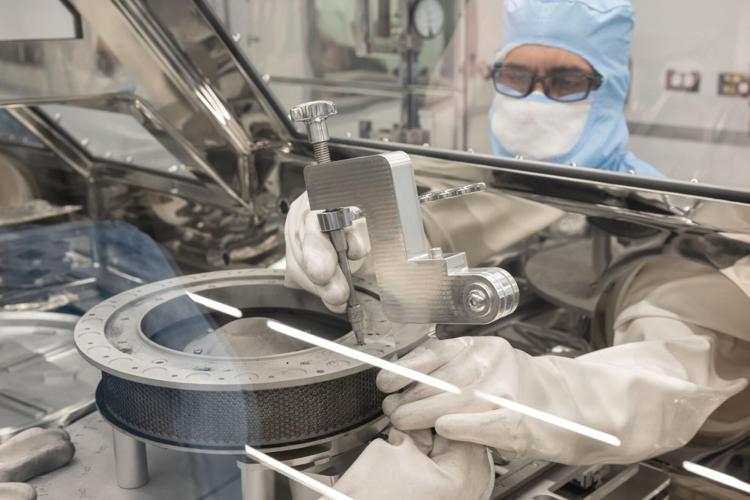The top has finally been popped on a stubborn piece of hardware that was keeping scientists away from precious asteroid samples delivered to Earth last year by a University of Arizona-led space mission.
After about three months of trying, specialists at NASA’s Johnson Space Center in Houston on Wednesday successfully removed two stuck fasteners on the sampling mechanism sent back by the OSIRIS-REx spacecraft.
The curation team at Johnson can now finish disassembling the mechanism and retrieve the bulk of the rocks and dust that were returned to Earth from the asteroid Bennu.
“We are all excited to see the remaining treasure OSIRIS-REx holds,” said Eileen Stansbery, division chief for Astromaterials Research and Exploration Science at Johnson.
More than 70 grams of asteroid material have already been painstakingly collected and cataloged from inside the protective capsule that landed in the desert west of Salt Lake City on Sept. 24.
The original goal of the $1.2 billion mission was to bring back at least 60 grams of rocky debris left over from the formation of the solar system about 4.5 billion years ago.
Once engineers are done disassembling the spacecraft’s Touch-and-Go Sample Acquisition Mechanism, or TAGSAM, the remaining bits of Bennu will be photographed, removed and weighed to determine exactly how much asteroid material OSIRIS-REx successfully captured.
“Finally having TAGSAM head open and full access to the returned Bennu samples is a monumental achievement that reflects the unwavering dedication and ingenuity of our team,” said the mission’s principal investigator, Dante Lauretta, a Regents Professor at the UA’s Lunar and Planetary Laboratory.
Earlier estimates indicate there could be as much as 180 grams of rocks and dust still inside the sampler head, bringing the mission’s total haul to roughly 250 grams.
OSIRIS-REx launched in September 2016 and arrived at Bennu in December 2018.
The robotic spacecraft briefly touched down on the asteroid’s surface on Oct. 20, 2020, to collect its samples, before departing for Earth in May 2021.
To remove the last two fasteners on the sampling head, engineers at NASA’s specially built OSIRIS-REx Sample Curation Laboratory at Johnson had to design, fabricate and test two new multi-part tools equipped with custom-made bits made from a specific grade of surgical, non-magnetic stainless steel.
The tools had to be small enough to fit inside the sealed, nitrogen-gas-filled glovebox where the sampling head is being kept to protect the asteroid samples from earthly contamination.
“In addition to the design challenge of being limited to curation-approved materials to protect the scientific value of the asteroid sample, these new tools also needed to function within the tightly confined space of the glovebox, limiting their height, weight and potential arc movement,” said Nicole Lunning, OSIRIS-REx curator at Johnson. “The curation team showed impressive resilience and did incredible work to get these stubborn fasteners off the TAGSAM head so we can continue disassembly. We are overjoyed with the success.”
Enough asteroid material was collected before the sampling head was opened to fulfill all of the sample requests received so far from the OSIRIS-REx science team.
That includes roughly 150 milligrams of asteroid material that has already been delivered to the U of A’s Kuiper-Arizona Laboratory for Astromaterials Analysis, a world-class suite of high-tech instruments capable of probing the asteroid grains down to the atomic level.
Lauretta said another shipment of Bennu bits totaling 100 mg or so was due to arrive on Thursday.
A portion of the asteroid material collected so far by the curation team at Johnson has been hermetically sealed to preserve it for decades to come. Some of it is being stored at ambient temperatures, and some has been chilled to minus 112 degrees Fahrenheit.
Later this spring, the curation team will release a full catalog of the OSIRIS-REx bounty, which will be made available to scientists all over the world.
“We eagerly anticipate the next chapter as we share these precious samples with the global scientific community and continue our journey of discovery,” Lauretta said.
The Tucson-born asteroid mission begins its pursuit of its next target.





